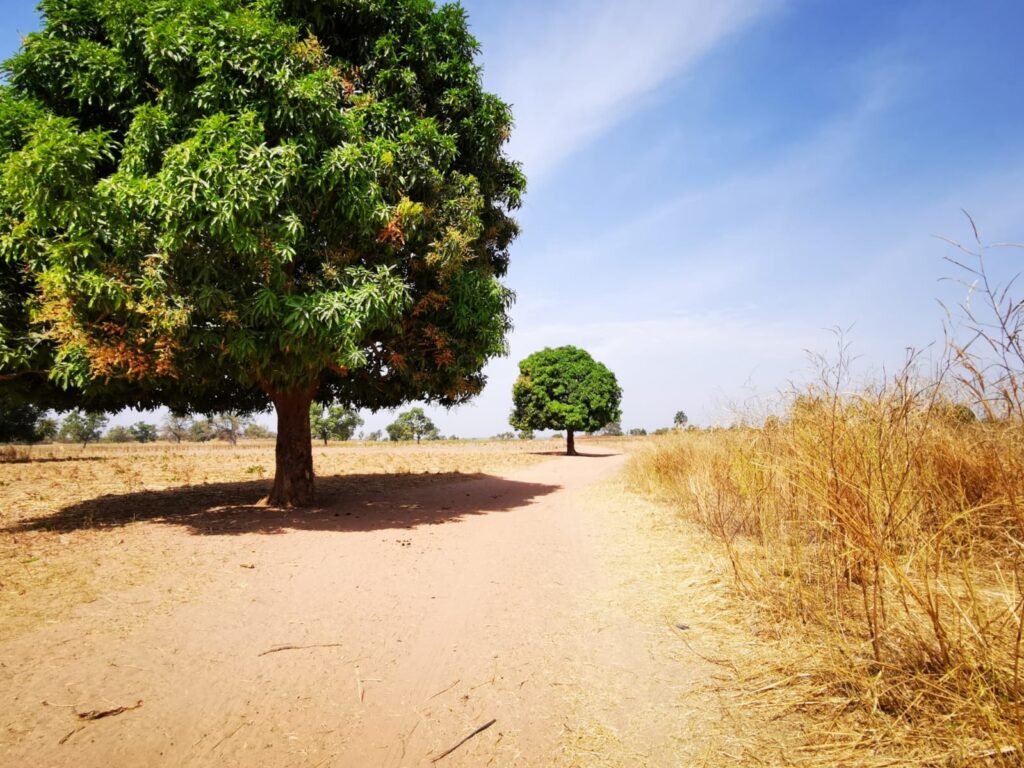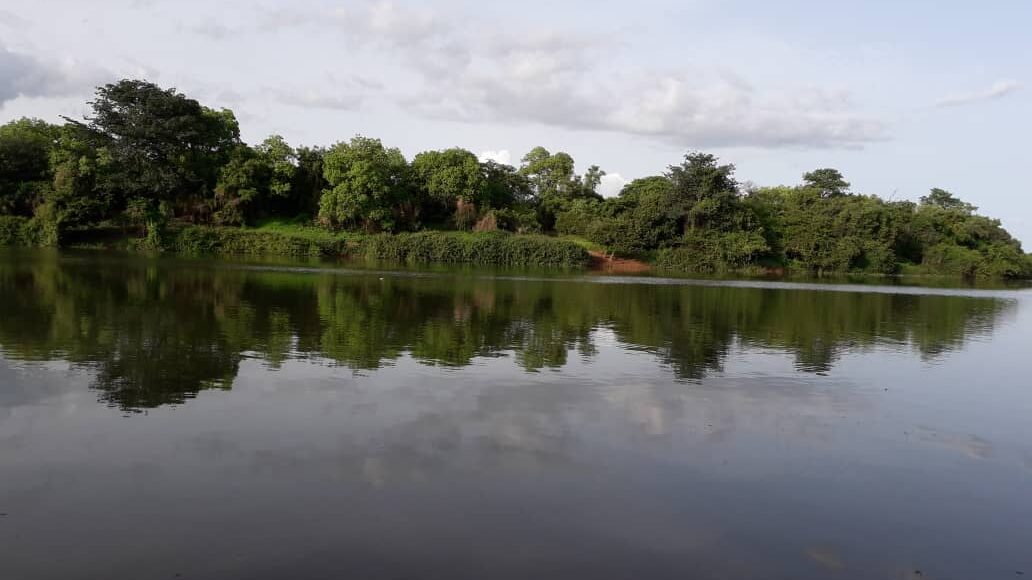
The first settlers of the closest proximity to Tambasansang were the Fulas who lived around “Bantantoo Seta Bal Koto“. Falai and his family settled briefly in “Jam Do Kairi” before moving to another area they referred to as “Su Kutoto” Meaning the new home this was due to the flood nature of “Jam Do Kairi” from there, they moved to Tambasansang after the Fulas left. The Fulas eventually moved to a new settlement called “Farato” on the other bank of Lake Tambasansang closer to Sutukonding because they became uncomfortable with the powerful nature of Falai and his people.
Tanda Mamodou and Falai Kora’s father, Mamadi Kora, hailed from Kong in the Northern region of Ivory Coast Mamadi Kora’s Father’s name is Mamudo Kora referred to as (Munno) who is perceived to come from a Ginn lineage “Ginna Siyo”. Falai Kora’s cousin Sanufoday Kora, was a brave warrior involved in many battles and emerged victorious every time. He fought in a battle called “WuyuWaya Kelo” and captured approximately 75 people, whom he enslaved. In his lifetime, it was narrated that he captured around 125 people and enslaved them to become his servants. His brother, Madi Kora, and Musa Kora both settled in Mali who are all sons of Alkurangba Kora, while Tanda Mamudou and Julaba Falai Kora traveled from Tanda to Bundu due to war and hardship that erupted in Tanda. Tanda was a vast settlement that was not under the control of any single kingship at the time Tanda Mamudou and Falai Kora left. “Satadugu” was the capital of Tanda, which was under the control of the Kora Kunda Family. Their fathers, Alkurangba Kora and Mamadi Kora who are both sons of Monno Kora “Ginna Siyo”, were the first rulers of Tanda.
When chaos erupted, some people settled in “Satadugu” at the Kora’s Dome refered to as “TATABA KOTO”. Some decided to leave the region of Tanda and migrate to new settlements. Tanda Mamodou and Falai Kora migrated to Bundu, which is their maternal home; Bundu is where their mother, called Sona Fadia, came from. Sona Fadia had two sisters, Sireng Fadia, mother to Simoto Kemo, and Sakandeh Fadia, mother to Mansa Tamba Wally, who is the founder of present-day Tamba in Senegal. These three sisters share the same parents, and they all hailed from Bundu. Due to Tanda Mamudo and Falai’s affiliation to Bundu, they decided to migrate there in search of a better settlement.
When they arrived in Bundu, with hope to meet their older cousin brother, Simoto Kemo, son to Sireng Fadia. Simoto Kemo was a native of Bundu; he was born and raised in Bundu, and both his parents are from Bundu. Upon Tanda Mamodou and Falai’s arrival in Bundu, they were informed that Simoto Kemo had migrated to a new settlement that he found, which was named after him, called Simoto Touba. Simoto Kemo was a Quranic scholar and a well-respected marabout, so he migrated to this new settlement with his students called “Talibol.” According to tradition, marabouts move to create their own settlements when they complete their studies of the Quran and the practice of becoming a marabout, which resulted in Simoto Kemo’s move to Simoto Touba. Tanda Mamudou and his brother Falai did not stay for long in Bundu and proceeded to meet their cousin Simoto Kemo in his new settlement, Simoto Touba, which is located in the present-day region of Senegal

Falai becoming a successful trader and powerful ruler. He reared various animals and cultivated different crops using farming methods and techniques available at the time.
Falai was a man of the people, always socializing with the griots, leather workers, blacksmiths, and slaves. These different groups of people lived together harmoniously and played their respective roles towards the socio-economic development of Tambasansang.
The people of Tambasansang lived in an extended family system. They lived in big, populated compounds accommodating fathers, mothers, brothers, sisters, grandchildren, and other peripheral family members. Individual families and compounds ate, worked, and did everything together under the name of their respective family, household, or compound. Each of these structures had a head or adviser.
Tambasansang is one of the most connected villages in The Gambia West Africa, if not the most connected, thanks to marriage. All the families in Tambasansang married with their respective family lines outside and even beyond Senegal and Guinea Bissau.
Tambasansang is a culturally rich settlement known for its respect and honor among the people of Tumana, Upper River Rigion of The Gambia, and beyond. All ceremonies held in Tambasansang, be it a naming ceremony, marriage ceremony, circumcision ceremony, etc., are marked by cultural performances such as cultural drums, kankurangs ( Masquerades), cultural singing, and dancing. The community has a system that guides and beautifies these activities and programs.
Most of the people in Tambasansang are farmers, and they prepare themselves ahead of the farming season by getting all their farming tools and inputs ready before the first rain. The farming equipments and supporting domestic animals are on standby, waiting for the start of the raining season, and the farmlands are cleared for sowing seeds. Food supplies are also gathered in stores for the whole course of the raining season. Youth, being the biggest asset and resources in the community, are requested to come back home and help out during the raining season, all these are early preparations ahead of the farming season in Tambasansang.
Since the inception of Tambasansang, there has always been a village head called the Alkalo, who is the head of Tambasansang and holds the final verdict on issues in the village. The Family of Falai Kora still hold the mantle of leathership (Alkaloship) in Tambasansang. The “Kanyellengs” are the traditional entertainers and singers, who spread messages and information across the society voluntarily.
The community mainly depends on natural food and their products like Nyeleng, Futo, Sato, Sereng, Parabasang, Jukkaa of many forms, etc., using fish from the fresh lake of Tambasansang. Chickens are from locally reared poultry, meat from home grown goats, sheep and cattle. Garden vegetables, and fruits are all locally grown in the surrounding of Tambasansang. The community is blessed with approximately 30 different types fruits or more.
During cultural programs and activities, traditional dresses of all sorts are worn in Tambasansang, with Haftan, Fatari Fanos, Bechos, Kulenbeng, Fainganno, etc., being some of the traditional and cultural attires.
Women in Tambasansang, like any other women, bear the greatest burden in caring for families. They do cooking, fetching drinking and washing waters, work in farms, gardens, arrange and clean houses, take care of younger ones in the families, and participate fully in social lives and activities. Women hold the family together the most in Tambasansang.
Kankurangs are dancers and some are also singers, making them the most entertaining masquerade in the community. They possess some spiritual powers and talents, which make them stand out. ‘Semalu’ are the lead and controllers of circumcision, who also possess certain spiritual powers, and they look after the young initiates during their stay in the bush.
The leather workers in Tambasansang make jujus, shoes, belts, etc., and are very talented in showing their artwork. Blacksmiths work mainly on metals, with talents and skills in bending, flattening, and designing metal to a desired look and function. They make hoes, plowing machines, cutlasses, axes for the society.
The local drums used in Tambasansang are the beleng, kutiro, beremeto, junjung, tabulo, etc. Communication means include meetings, messengers, Kankularo, flute, etc.
Contributors: Alieu Suso – Boto Kora – Mamo Kora